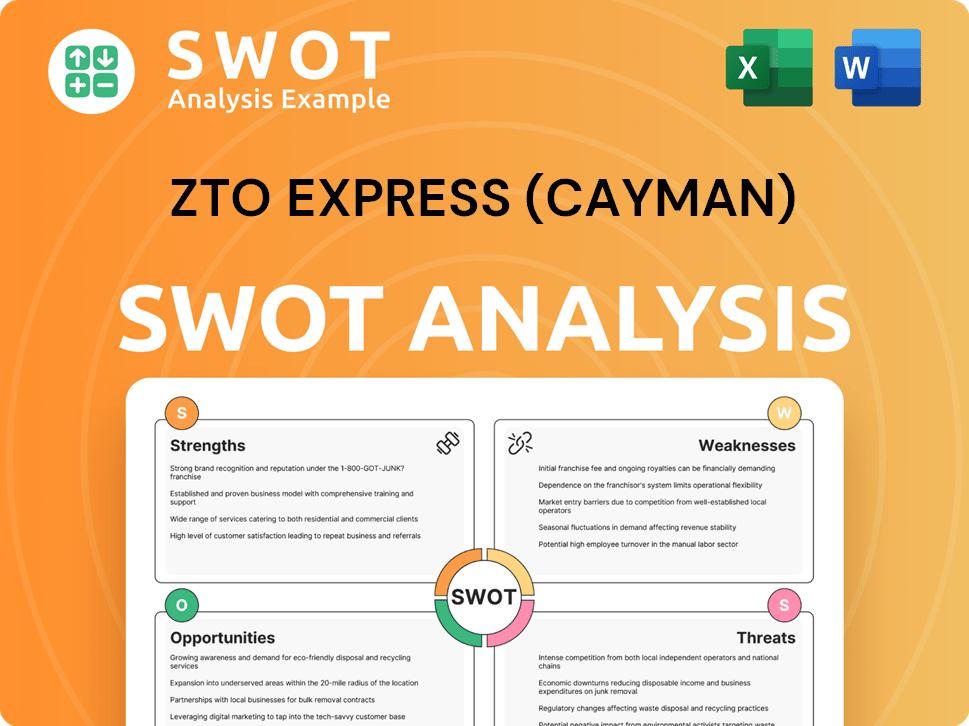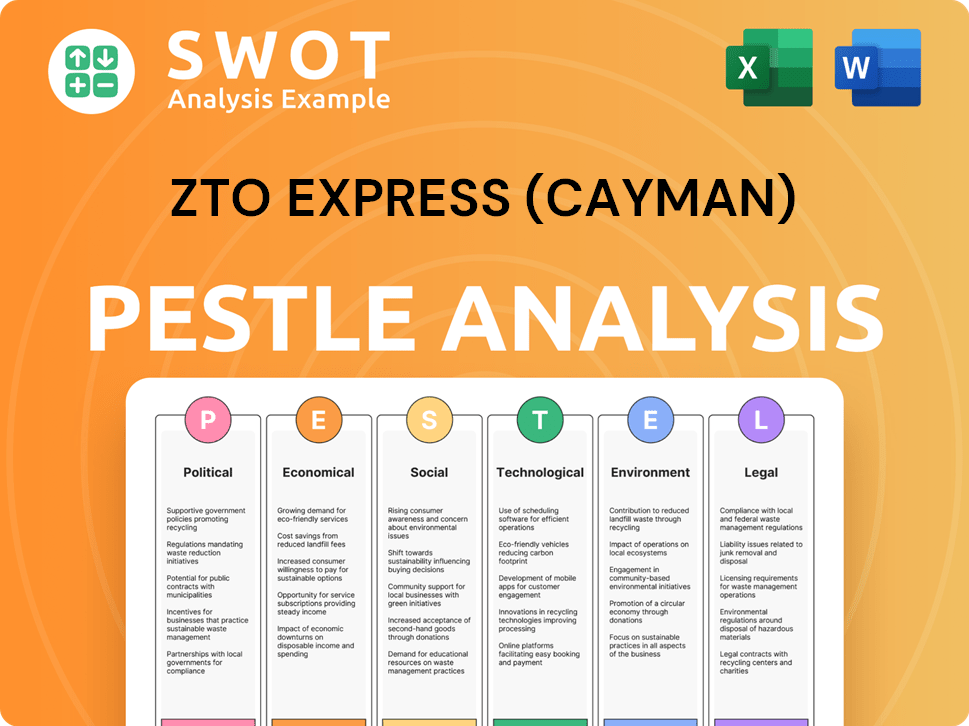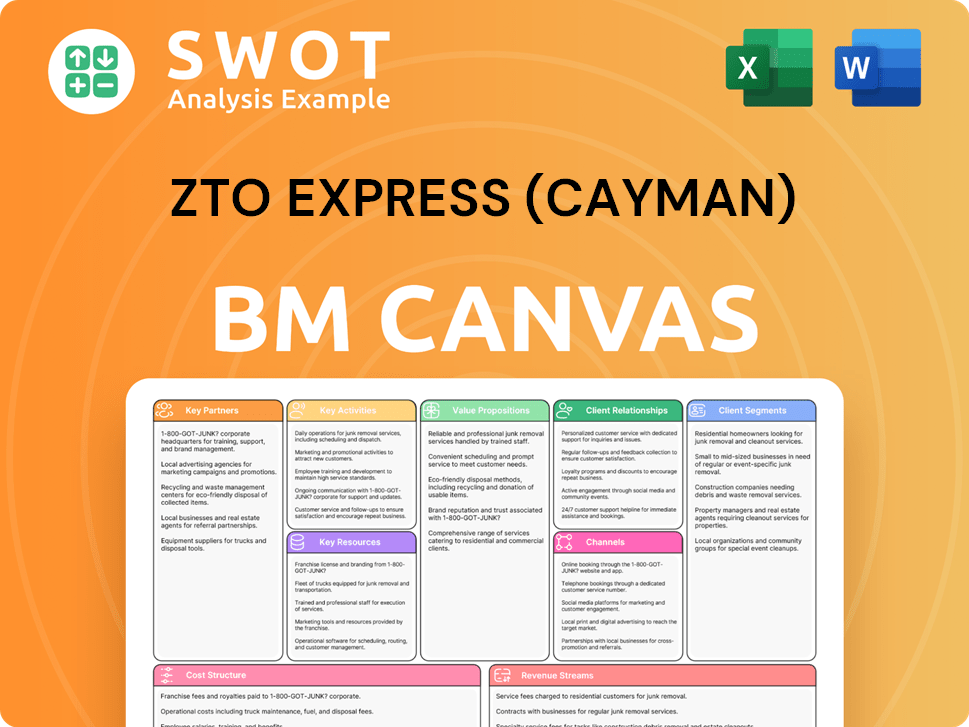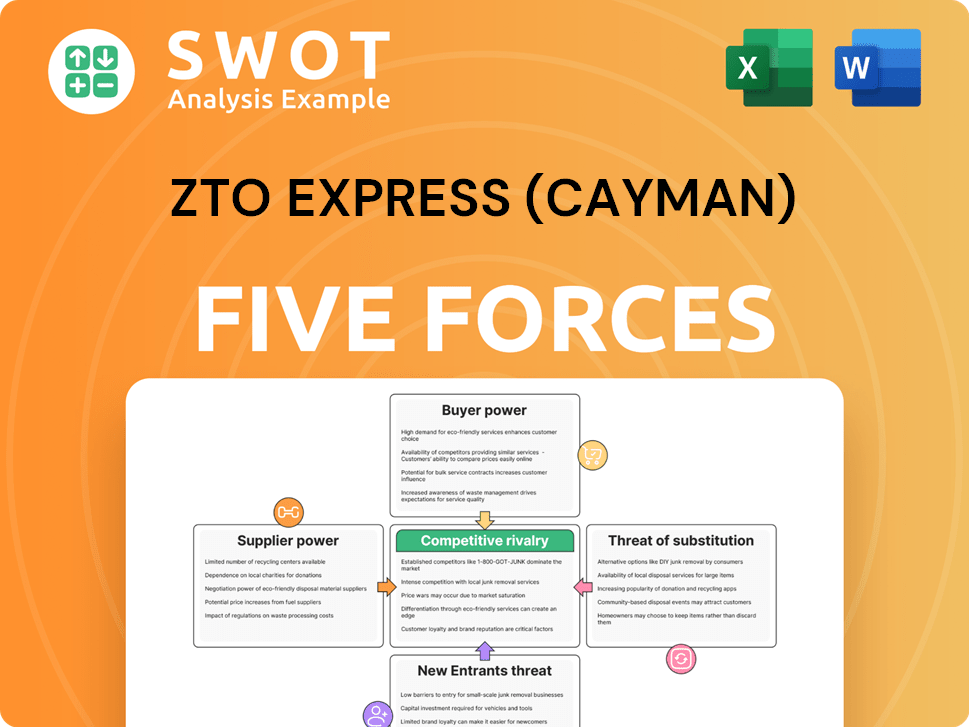ZTO Express (Cayman) Bundle
How Did ZTO Express Conquer the Chinese Delivery Market?
Born from the e-commerce boom, ZTO Express (Cayman) Company revolutionized Chinese logistics. Founded in 2002, it quickly became a key player in the Chinese express delivery sector. Its innovative network partner model set the stage for rapid expansion across China's vast landscape.

From its inception, ZTO Express has demonstrated remarkable growth, consistently ranking among the top express delivery companies. Understanding the ZTO Express (Cayman) SWOT Analysis is crucial to grasp its strategic moves. This article will explore the ZTO history and ZTO company profile, offering insights into its ZTO logistics successes and challenges, from its early days to its current market dominance. We'll examine the brief history of ZTO Express Cayman, its ZTO Express market share, and its strategic decisions.
What is the ZTO Express (Cayman) Founding Story?
The founding story of ZTO Express (Cayman) is rooted in the early 2000s, a period of significant growth in China's e-commerce sector. The company emerged to address the inefficiencies in the existing express delivery infrastructure, aiming to provide a more streamlined and scalable solution. This focus on the burgeoning online retail market was a key driver of its initial strategy and subsequent success.
ZTO Express was established on May 8, 2002. Lai Meisong, leveraging his experience in transportation and logistics, spearheaded the venture. He recognized the potential of the rapidly expanding e-commerce market and the need for a robust delivery network to support it. The company's early days were characterized by a pragmatic approach, focusing on building a network that could handle the increasing volume of parcels.
The company's initial business model was innovative, utilizing a network partner approach. This allowed for rapid expansion with relatively lower capital expenditure. ZTO Express focused on trunk line transportation and sorting centers, while empowering local entrepreneurs to manage regional delivery operations. The first services offered were parcel pick-up and delivery, primarily catering to the growing e-commerce sector. The company's initial funding was primarily self-financed by the founders, supplemented by contributions from friends and family, reflecting a bootstrapped approach to establishment. The name 'ZTO' itself was chosen to reflect a commitment to speed and accessibility, aiming to become a ubiquitous presence in express delivery.
ZTO Express's founding was driven by the growth of e-commerce in China and the need for a more efficient delivery system.
- Founded: May 8, 2002, by Lai Meisong.
- Business Model: Network partner approach, focusing on trunk line transportation and sorting.
- Initial Services: Parcel pick-up and delivery, targeting the e-commerce sector.
- Funding: Primarily self-financed, with contributions from friends and family.
ZTO Express (Cayman) SWOT Analysis
- Complete SWOT Breakdown
- Fully Customizable
- Editable in Excel & Word
- Professional Formatting
- Investor-Ready Format

What Drove the Early Growth of ZTO Express (Cayman)?
The early years of ZTO Express were marked by rapid growth, driven primarily by the booming e-commerce sector in China. The company's network partner model facilitated a swift expansion across the nation. By 2005, ZTO Express had established a significant presence in numerous provinces and major cities. Parcel volumes grew year-over-year, reflecting the increasing adoption of online shopping by both consumers and businesses.
ZTO Express focused on building a comprehensive delivery network. This involved strategic investments in sorting hubs and transportation infrastructure. The company aimed to optimize operations to reduce delivery times and improve efficiency. This expansion was crucial for capturing market share in the competitive Chinese express delivery market.
Continuous investment in technology was a key strategy for ZTO Express. Automated sorting equipment significantly improved processing capabilities. These technological advancements helped ZTO to handle increasing parcel volumes more efficiently. This focus on technology gave ZTO a competitive edge in the market.
ZTO Express began offering value-added services, such as warehousing and supply chain management. These services catered to the evolving needs of its e-commerce clients. By providing a broader range of services, ZTO enhanced its value proposition. This helped ZTO attract and retain major e-commerce businesses.
The Chinese express delivery market was highly competitive. ZTO Express managed to maintain competitive pricing while improving service quality. This strategy allowed ZTO to gain traction and solidify its position. By the late 2000s, ZTO had become a leading express delivery provider in China.
ZTO Express (Cayman) PESTLE Analysis
- Covers All 6 PESTLE Categories
- No Research Needed – Save Hours of Work
- Built by Experts, Trusted by Consultants
- Instant Download, Ready to Use
- 100% Editable, Fully Customizable

What are the key Milestones in ZTO Express (Cayman) history?
The ZTO Express has achieved several significant milestones, shaping its trajectory in the Chinese express delivery market and beyond. A key moment in the ZTO history was its initial public offering (IPO) in 2016, which provided substantial capital for expansion. This move solidified its position as a major player in the logistics sector.
| Year | Milestone |
|---|---|
| 2016 | ZTO Express completed its IPO on the New York Stock Exchange, raising approximately $1.4 billion. |
| 2018 | ZTO Express reached a daily parcel volume exceeding 20 million, demonstrating significant growth. |
| 2023 | The company handled over 30 billion parcels, showcasing its extensive delivery network and market reach. |
ZTO Express has consistently integrated innovation to enhance its operational efficiency and service quality. The company has been at the forefront of automation within its sorting hubs, utilizing advanced technology to manage the increasing volume of parcels.
ZTO has implemented automated sorting lines and robotic technology to increase efficiency and reduce manual labor in its sorting centers. These systems can process a large number of parcels quickly and accurately, improving overall throughput. This technology helps ZTO maintain its competitive edge in the fast-paced express delivery market.
The company uses data analytics to optimize its delivery routes, predict demand, and manage its logistics network more effectively. This allows for better resource allocation and improved customer service. By analyzing data, ZTO can make informed decisions that enhance its operational efficiency and customer satisfaction.
ZTO continually optimizes its delivery network to reduce transit times and costs. This involves strategic placement of sorting centers and hubs, as well as efficient route planning. These enhancements help ZTO maintain its competitive edge in the express delivery market.
ZTO integrates technology across all aspects of its operations, from tracking and tracing to customer service. This integration ensures seamless information flow and improved service quality. This approach helps ZTO manage the complexities of its large-scale operations.
ZTO is investing in smart warehousing solutions to improve inventory management and order fulfillment. These systems use automation and data analytics to streamline warehouse operations. This helps the company meet the growing demands of e-commerce.
ZTO is expanding its use of electric vehicles to reduce emissions and operational costs. This initiative supports the company's sustainability goals and enhances its brand image. The deployment of EVs is part of ZTO's broader strategy to modernize its fleet and reduce its environmental impact.
Despite its successes, ZTO Express has faced several challenges, including intense competition and fluctuating operational costs. The company has had to navigate pricing pressures within the Chinese express delivery market, affecting profit margins.
The Chinese express delivery market is highly competitive, with numerous players vying for market share. This competition leads to pricing pressures and the need for continuous service improvements. ZTO must continually innovate and optimize its operations to stay ahead.
Competition often results in price wars, which can squeeze profit margins for express delivery companies. ZTO must balance competitive pricing with the need to maintain profitability. This involves optimizing costs and finding new revenue streams.
Fuel costs, labor expenses, and other operational costs can fluctuate, impacting profitability. ZTO must manage these costs effectively to maintain its financial performance. This requires careful planning and strategic investments.
Managing a vast network of partners and ensuring consistent service quality across all regions is a complex task. ZTO needs robust oversight and technological integration to maintain high standards. This involves continuous monitoring and improvement of its network.
Economic downturns can impact consumer spending and the demand for express delivery services. ZTO must adapt to changing market conditions and manage its resources prudently. This includes diversifying its services and expanding into new markets.
Changes in regulations related to logistics and transportation can pose challenges. ZTO must comply with new rules and adapt its operations accordingly. This requires staying informed and adjusting its strategies to meet regulatory requirements.
ZTO Express (Cayman) Business Model Canvas
- Complete 9-Block Business Model Canvas
- Effortlessly Communicate Your Business Strategy
- Investor-Ready BMC Format
- 100% Editable and Customizable
- Clear and Structured Layout

What is the Timeline of Key Events for ZTO Express (Cayman)?
The ZTO Express, a key player in the Chinese express delivery sector, has a rich history marked by significant growth and strategic milestones. Founded on May 8, 2002, the company quickly established a nationwide network, expanded its infrastructure, and embraced automation. Key moments include its initial public offering (IPO) in 2016 and a secondary listing in Hong Kong in 2020. By 2023, ZTO Express had delivered over 30 billion parcels, solidifying its position as a leader in the industry. This growth reflects its ability to adapt and innovate within the dynamic e-commerce landscape.
| Year | Key Event |
|---|---|
| May 8, 2002 | ZTO Express is founded in Shanghai, China, marking the beginning of its journey in the Chinese express delivery market. |
| 2005 | ZTO establishes a comprehensive nationwide network, significantly expanding its operational footprint across China. |
| 2010 | The company begins investing heavily in automated sorting equipment, enhancing efficiency and capacity. |
| October 27, 2016 | ZTO Express goes public on the New York Stock Exchange (NYSE), a pivotal moment in its corporate history. |
| 2018 | ZTO achieves an annual parcel volume exceeding 10 billion, showcasing substantial growth in its delivery operations. |
| 2020 | Completes a secondary listing on the Hong Kong Stock Exchange, expanding its investor base and capital access. |
| 2022 | Celebrates its 20th anniversary, highlighting two decades of growth and adaptation in the logistics sector. |
| 2023 | Reports an annual parcel volume exceeding 30 billion, demonstrating continued market dominance. |
| Early 2024 | Maintains a leading market share in China's express delivery industry, reflecting its strong competitive position. |
ZTO Express is focused on enhancing its network efficiency through strategic investments in technology and infrastructure. This includes optimizing sorting processes, expanding delivery routes, and improving overall operational speed. The goal is to reduce costs and improve delivery times. This focus is crucial for maintaining a competitive edge in the Chinese express delivery market.
The company aims to broaden its global presence to tap into the expanding cross-border e-commerce market. This involves establishing partnerships, expanding its service coverage in key international markets, and enhancing its logistics capabilities. This strategy is designed to capture growth opportunities beyond China. Recent reports indicate ZTO is increasing its presence in Southeast Asia.
ZTO plans to leverage advanced technologies such as AI, big data, and automation to improve operational efficiency and customer experience. This includes implementing smart logistics solutions, enhancing tracking systems, and personalizing services. The company is investing in digital transformation to stay ahead of industry trends. This will help ZTO to optimize its delivery network.
The ongoing growth of e-commerce, particularly in rural areas and international trade, presents significant opportunities for ZTO Express. The company is well-positioned to capitalize on these trends due to its robust network and strategic partnerships. Analysts predict continued growth in parcel volumes. This is supported by its commitment to innovation and customer service.
ZTO Express (Cayman) Porter's Five Forces Analysis
- Covers All 5 Competitive Forces in Detail
- Structured for Consultants, Students, and Founders
- 100% Editable in Microsoft Word & Excel
- Instant Digital Download – Use Immediately
- Compatible with Mac & PC – Fully Unlocked

Related Blogs
- What is Competitive Landscape of ZTO Express (Cayman) Company?
- What is Growth Strategy and Future Prospects of ZTO Express (Cayman) Company?
- How Does ZTO Express (Cayman) Company Work?
- What is Sales and Marketing Strategy of ZTO Express (Cayman) Company?
- What is Brief History of ZTO Express (Cayman) Company?
- Who Owns ZTO Express (Cayman) Company?
- What is Customer Demographics and Target Market of ZTO Express (Cayman) Company?
Disclaimer
All information, articles, and product details provided on this website are for general informational and educational purposes only. We do not claim any ownership over, nor do we intend to infringe upon, any trademarks, copyrights, logos, brand names, or other intellectual property mentioned or depicted on this site. Such intellectual property remains the property of its respective owners, and any references here are made solely for identification or informational purposes, without implying any affiliation, endorsement, or partnership.
We make no representations or warranties, express or implied, regarding the accuracy, completeness, or suitability of any content or products presented. Nothing on this website should be construed as legal, tax, investment, financial, medical, or other professional advice. In addition, no part of this site—including articles or product references—constitutes a solicitation, recommendation, endorsement, advertisement, or offer to buy or sell any securities, franchises, or other financial instruments, particularly in jurisdictions where such activity would be unlawful.
All content is of a general nature and may not address the specific circumstances of any individual or entity. It is not a substitute for professional advice or services. Any actions you take based on the information provided here are strictly at your own risk. You accept full responsibility for any decisions or outcomes arising from your use of this website and agree to release us from any liability in connection with your use of, or reliance upon, the content or products found herein.